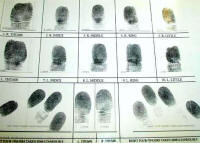|
CRIMINALISTICS
The Criminalistics Section evaluates and analyzes evidence for the presence of
fingerprints, palm prints and footprints. Any one of these types of
prints can be formed by the impression of the friction ridges (raised
portion) present on skin. The impression left can be made by the
natural secretions from sweat glands in friction ridge skin, referred to
as a latent print. A latent print is a crime scene print. Normally it
is invisible, but not always. Processing allows the print to be
visualized. Or they can be made by ink or other materials transferred
from the peaks of the friction ridge skin to a relatively smooth
surface, referred to as a patent print.
Two types of
evidence are typically submitted: lift-cards that have latent prints
taken from a crime-scene, and objects to be processed at the laboratory
for the presence of latent prints. The section receives a variety of
types of evidence for latent print processing. Some examples include:
paper, (e.g. checks, notebooks, letters, money); plastic, (e.g. plastic
bags, credit cards, bottles); glass, (e.g. bottles, mirrors); metal,
(e.g. guns, knives, cash registers).
The composition of
an object will determine which processing technique will be utilized to
develop latent prints. There are a variety of chemical and physical
methods that can be used including superglue fuming, luminescence
(laser), dye staining, powdering, ninhydrin and physical developer.
Many of these techniques can be used in tandem, for example, a plastic
bag would first be superglue fumed then processed with Rhodamime dye.
 |
|
Fingerprint
Record |
After the analyst
has processed the evidence to preserve and develop prints, the items are
photographed. The ridge detail observed in the photographs is then
examined to determine if it is of value for comparison. This evaluation
process is also conducted on submitted lift-cards. The first step is to
compare any prints that are of value to the victimís record
fingerprints, or to anyone who had legitimate access to the crime
scene. Sixty to seventy percent of latent prints examined are
identified as belonging to the victim. The second step is to then
compare any remaining unidentified prints to the suspectís fingerprint
record. The third step, if there are any remaining unidentified
fingerprints, is to enter them into the Automated Biometrics Identification System (ABIS)
(formely known as AFIS).
The Illinois State
State Police database contains over 3 million sets of fingerprints from arrestees,
job applicants, police officers and civil service employees in the State
of Illinois. The laboratory also has access to the Federal Bureau of
Investigation (FBI) Next Generation Identification (NGI) database.
A search of the ABIS
system will produce a list of persons whose fingerprint resembles the
entered print. The analyst will then obtain a copy of the original
fingerprint record to conduct the comparison. An identification is made
when the examiner determines that there are enough characteristics that
correspond in both the questioned and known print that allows the
examiner to conclude they were made by the same person.
|